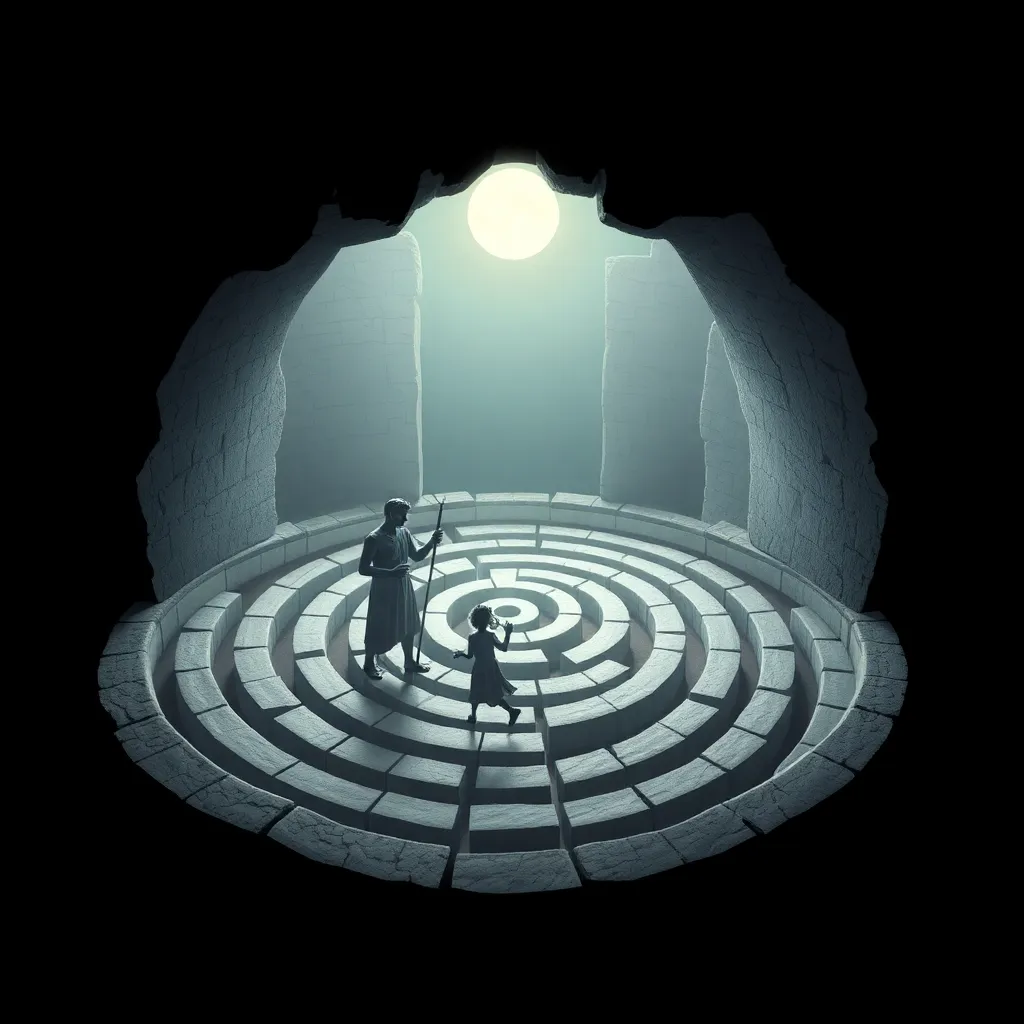The Symbolism of the Labyrinth in Theseus’s Journey
I. Introduction
The myth of Theseus and the Minotaur is one of the most compelling tales in Greek mythology. It tells the story of Theseus, a hero who ventures into the complex labyrinth designed by Daedalus to confront the Minotaur, a beast that is half-man and half-bull. The labyrinth itself is not merely a physical structure; it serves as a crucial symbol within the narrative, representing the challenges and choices that Theseus must navigate.
This article aims to explore the multifaceted symbolism of the labyrinth in Theseus’s journey, examining its historical context, psychological implications, and the lessons it imparts about choice, collaboration, and inner conflict.
II. Historical Context of the Labyrinth
The origins of the labyrinth myth are rooted in ancient Crete, where the Minoan civilization flourished. The term ‘labyrinth’ is derived from the Minoan word ‘labrys,’ meaning double-headed axe, which was a symbol associated with the Minoan culture. The legend of the Minotaur, born from the union of Pasiphaë and a bull, and confined within the labyrinth, reflects the complexities of human nature and societal structures.
Throughout ancient civilizations, labyrinths have been interpreted in various ways:
- As sacred spaces for meditation and reflection
- As symbols of the cyclical nature of life and death
- As representations of the journey toward enlightenment
In Greek mythology, the labyrinth serves as a powerful symbol of the struggle against chaos and the pursuit of order.
III. The Labyrinth as a Representation of Complexity and Confusion
The physical structure of the labyrinth is a marvel of design, characterized by its intricate pathways and dead ends. This complexity mirrors the confusion and uncertainty that individuals face in their lives. Navigating through the labyrinth becomes a metaphor for the psychological journey one embarks upon when confronting personal challenges.
Theseus’s journey through the labyrinth can be interpreted as a representation of personal struggles, where the hero must confront not only the Minotaur but also the chaos within himself. The labyrinth symbolizes the trials and tribulations that everyone faces, emphasizing the importance of perseverance and courage in the face of adversity.
IV. The Labyrinth and the Theme of Choice
Choice plays a pivotal role in Theseus’s quest. Upon entering the labyrinth, he is faced with numerous paths, each representing different decisions that could lead to success or failure. The symbolism of the paths within the labyrinth reflects the complexity of decision-making in life:
- Each choice carries consequences, shaping one’s destiny.
- The choices made in moments of crisis define one’s character.
- Theseus’s resolve to confront the Minotaur illustrates the courage to face one’s fears.
The labyrinth serves as a reminder that in the face of adversity, the choices we make can lead us toward liberation or entrapment.
V. The Role of Ariadne and the Thread of Fate
Ariadne, the daughter of King Minos, plays a crucial role in Theseus’s success by providing him with a thread to navigate the labyrinth. This thread symbolizes guidance, support, and the connection to one’s fate. Ariadne’s assistance underscores the importance of collaboration in overcoming challenges.
The interplay between fate and free will is evident in Theseus’s journey. While he must make choices to navigate the labyrinth, Ariadne’s thread represents the guiding force of destiny that helps him find his way back to safety. This dynamic illustrates that while individuals have the power to choose their paths, external support can be instrumental in achieving their goals.
VI. The Labyrinth as a Representation of Inner Conflict
The Minotaur itself serves as a powerful symbol of Theseus’s inner demons. The beast represents the primal instincts and fears that reside within every individual. The battle between Theseus and the Minotaur is not merely a physical confrontation; it represents the struggle between rationality and chaos.
Overcoming the Minotaur can be seen as a metaphor for confronting personal fears and insecurities. Theseus’s victory symbolizes the triumph of reason over irrationality, highlighting the importance of self-awareness and courage in overcoming one’s inner conflicts.
VII. Modern Interpretations of the Labyrinth Symbolism
The symbolism of the labyrinth continues to resonate in contemporary literature and art. Modern interpretations often explore themes of personal growth, identity, and the challenges of navigating life’s complexities. Labyrinths are frequently used as metaphors for:
- The journey of self-discovery and personal development
- The challenges of mental health and emotional turmoil
- The intricacies of modern life and societal expectations
In psychological contexts, labyrinths are utilized in therapy as tools for exploring the mind, facilitating discussions about one’s inner turmoil and aiding in the journey toward healing.
VIII. Conclusion
The labyrinth in Theseus’s journey serves as a multifaceted symbol of complexity, choice, collaboration, inner conflict, and personal growth. Its rich historical context and psychological implications offer valuable insights into the human experience. Theseus’s tale reminds us of the challenges we face in life and the importance of courage, support, and self-awareness in overcoming them.
The enduring relevance of Theseus’s journey speaks to the universal struggle for meaning and clarity in a chaotic world. The lessons learned from the labyrinth experience encourage us to confront our fears, make conscious choices, and seek guidance as we navigate the intricate pathways of our lives.




